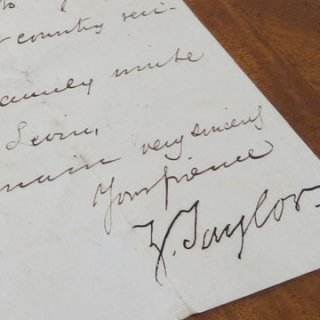President Taylor Shows Political Dexterity Deflecting an Invitation to Visit the Leader of the Know-Nothings, Which Would Have Been Politically Useful to Them But Was a Negative Association For the President



A very uncommon Taylor letter as President, in which he references his upcoming tour of the north, during which he would take seriously ill and almost die.
Born in Charleston, SC in 1808, Lewis Charles Levin was a Philadelphia politician and one of the most brilliant orators of his day. He served in Congress from 1845 to 1851, and was the first Jewish U.S. Congressman. Levin was an outspoken foe of the Roman Catholic Church, and was a leader...
Born in Charleston, SC in 1808, Lewis Charles Levin was a Philadelphia politician and one of the most brilliant orators of his day. He served in Congress from 1845 to 1851, and was the first Jewish U.S. Congressman. Levin was an outspoken foe of the Roman Catholic Church, and was a leader when riots erupted in Philadelphia during the summer of 1844 in which Catholic churches and institutions were burnt by a mob. Rather paradoxically for a Jew, he was one of the founders of the anti-immigrant Native American Party and movement (eventually known as the “Know Nothings”), and he published its newspaper, The Sun. In 1848 most in Levin’s party supported the Whig ticket, and their support was important to Zachary Taylor’s successful election bid. However, Taylor himself was personally disgusted by their Catholic-baiting and had no wish to encourage it. So in dealing with Lewis, the new President was involved in a delicate balancing act: setting his party’s desire for Native American Party votes and its need to avoid antagonizing prominent Native American Party leaders, against the risk of being tainted by any association with demogagory and a genuine disinclination to promote anti-Catholic and anti-immigration activism.
"If I leave the seat of government at all, it will be for a journey of some length through the northern states."
Letter Signed as President, July 26, 1849, to Levin, carefully managing his response to an invitation to visit Levin’s home, a visit that would boost the prestige and influence of Levin and his party but do nothing to benefit the President. “I have just received at the hands of Mr. Anderson your favor of the 23rd instant and must beg you to accept the cordial thanks of myself and family for your hospitable invitation to spend a few days at Prospect Hill. I fear, however, that it will not be practicable to avail ourselves of your kindness, for if I leave the seat of government at all, it will be for a journey of some length through the northern states. I should otherwise be most happy to enjoy the quiet and salubrity of your country residence. The ladies of my family unite in kind regards to Mrs. Levin.”
Taylor was walking on egg shells for good reason. In 1852, Levin and his party were strong enough to help tilt the Presidential election to Democrat Franklin Pierce when they abandoned the Whigs' candidate Winfield Scott (as there were Catholics in Scott's family and he was accused of Papist connections). Levin was an organizing speaker of the first Know-Nothing Party convention in March 1855, and the party succeeded in gaining Millard Fillmore’s agreement to be its standard bearer in the 1856 election.
As for the tour of the northern states Taylor speaks of here, he started on such a tour shortly after in August. However, he became ill with a violent attack of diarrhea and high fever a few days after leaving Washington and was bedridden. Taylor’s personal physician feared that the President had cholera and would not survive. The President recovered, continued the tour briefly, then returned to Washington where, after about a month, his health appeared to normalize. A similar attack would kill him less than a year later.

Frame, Display, Preserve
Each frame is custom constructed, using only proper museum archival materials. This includes:The finest frames, tailored to match the document you have chosen. These can period style, antiqued, gilded, wood, etc. Fabric mats, including silk and satin, as well as museum mat board with hand painted bevels. Attachment of the document to the matting to ensure its protection. This "hinging" is done according to archival standards. Protective "glass," or Tru Vue Optium Acrylic glazing, which is shatter resistant, 99% UV protective, and anti-reflective. You benefit from our decades of experience in designing and creating beautiful, compelling, and protective framed historical documents.
Learn more about our Framing Services







































































































